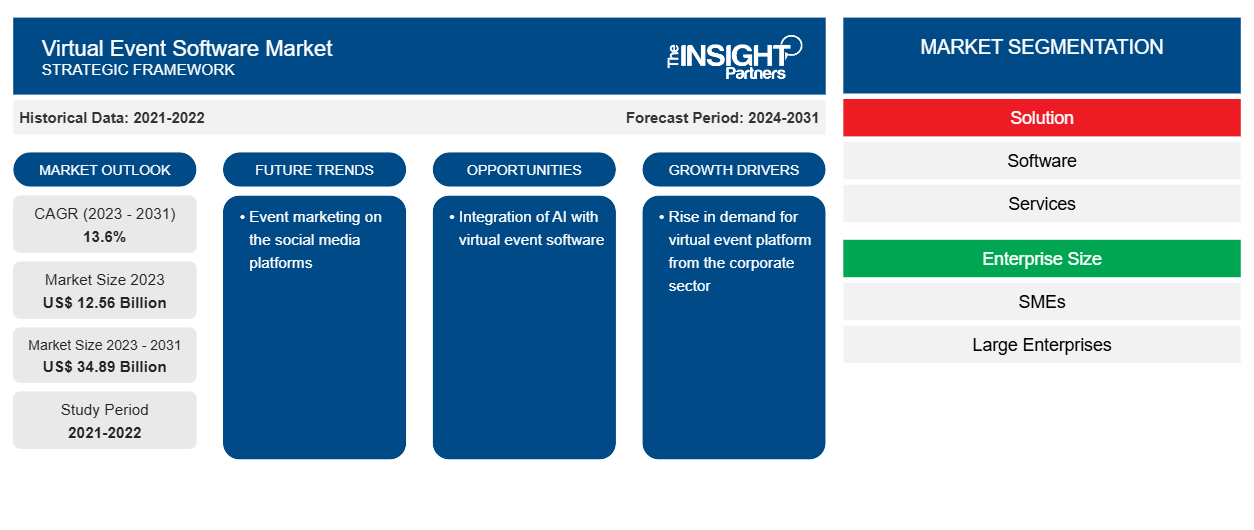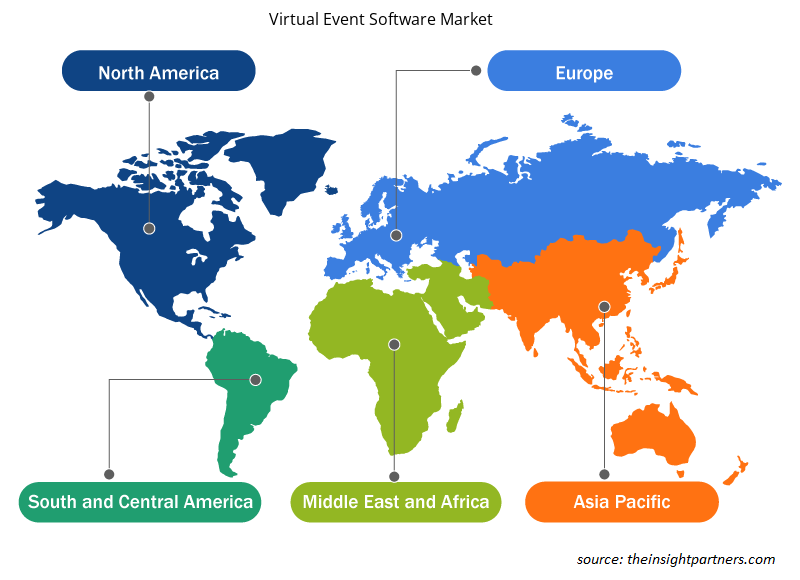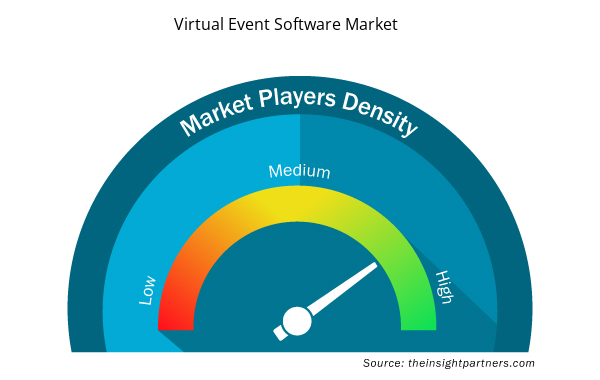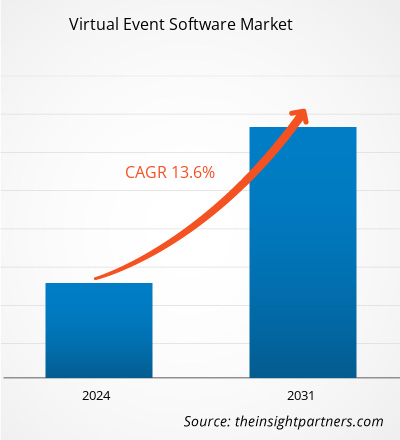The virtual event software market size is projected to reach US$ 34.89 billion by 2031 from US$ 12.56 billion in 2023. The market is expected to register a CAGR of 13.6% during 2023–2031. The growth in virtual events and the rise in the adoption of AI-based virtual event platforms are likely to remain key trends in the market.
Virtual Event Software Market Analysis
The virtual event software is gaining traction due to factors such as growing internet penetration, the rise in digitalization, and a boost in the work-from-home culture in the corporate sector. The ability of the virtual event software to engage the attendees with various engaging features such as one-on-one interaction, Q&A polls, live chats, emoticons, and others drives its demand among several end users such as corporates, event management companies, trade show organizers, academic institutions, and others.
Virtual Event Software Market Overview
Virtual event software helps to conduct events virtually in an efficient manner. It exhibits the same features as same as event management software. The only difference is that event management software also includes managing the event in person. Virtual event software has capabilities such as in-webcasting and integrates seamlessly with webinar software. It can integrate interactive content such as group chats, Q&A polls, and 1:1 networking. The user can also attend the event from any device.
Customize This Report To Suit Your Requirement
You will get customization on any report - free of charge - including parts of this report, or country-level analysis, Excel Data pack, as well as avail great offers and discounts for start-ups & universities
Virtual Event Software Market: Strategic Insights

- Get Top Key Market Trends of this report.This FREE sample will include data analysis, ranging from market trends to estimates and forecasts.
You will get customization on any report - free of charge - including parts of this report, or country-level analysis, Excel Data pack, as well as avail great offers and discounts for start-ups & universities
Virtual Event Software Market: Strategic Insights

- Get Top Key Market Trends of this report.This FREE sample will include data analysis, ranging from market trends to estimates and forecasts.
Virtual Event Software Market Drivers and Opportunities
Rise in demand for virtual event platforms from the corporate sector to Favor the Market
The corporate sector is experiencing the growing popularity of virtual gatherings which is one of the key factors driving the virtual event platform need. The wave of digital transformation, the COVID-19 pandemic, and the work-from-home culture in the corporate sector have generated the need for a solution to engage the employees and stakeholders of the company on a single integrated platform. Large corporate have their employees across the world. For the team bonding activities, the corporate organizes various events where their employees can engage. Team bonding event helps corporates create a high-performing team and develop space for employees where they can interact and know more about each other's diverse backgrounds and experiences. Thus, corporates organize events to create a healthy work environment and relationships with the employees, which further fuels their productivity in work.
Integration of AI with virtual event software
AI technology integrated technologies help the user to detect patterns and insights to uncover the gaps and opportunities that enhance the features of any software and processes. AI-integrated virtual event software can help to auto-creates the event agendas and automatic event planning. It can customize virtual venues and booths. It also helps to replicate the in-person experience on the virtual platforms. Some market players provide AI-based virtual event platforms. For example, EventsX is an AI-driven platform to organize, market, and host the perfect virtual, hybrid, or in-person event. It provides real-time and after-event analytics which helps the users to understand the customer's experiences. The event analysis also helps them to improve themselves for a future event by enhancing personalised customer experiences.
Virtual Event Software Market Report Segmentation Analysis
Key segments that contributed to the derivation of the virtual event software market analysis are solution, enterprise size, and end user.
- Based on the solution, the virtual event software market is divided into software and services. The software segment held the largest share of the market in 2023.
- By enterprise size, the market is segmented into SMEs and large enterprise. The SMEs are expected to grow with the highest CAGR during the forecast period.
- In terms of end user, the market is segmented into trade show organizers, event management agencies, corporates, academic organizations, and others. The corporates segment is expected to grow with a significant CAGR.
Virtual Event Software Market Share Analysis by Geography
The geographic scope of the virtual event software market report is mainly divided into five regions: North America, Asia Pacific, Europe, Middle East & Africa, and South & Central America.
Asia Pacific region is expected to grow with the highest CAGR during the forecast period. The rising digitalization, growth in the corporate sector, and proliferation of the internet in the region are some of the factors fuelling the Asia Pacific virtual event software market. Various software companies are expanding their presence and business in the region which further drives the market. The government's focus on boosting digitalization in the region has further complemented the market growth.
Virtual Event Software Market Regional Insights
The regional trends and factors influencing the Virtual Event Software Market throughout the forecast period have been thoroughly explained by the analysts at Insight Partners. This section also discusses Virtual Event Software Market segments and geography across North America, Europe, Asia Pacific, Middle East and Africa, and South and Central America.

- Get the Regional Specific Data for Virtual Event Software Market
Virtual Event Software Market Report Scope
| Report Attribute | Details |
|---|---|
| Market size in 2023 | US$ 12.56 Billion |
| Market Size by 2031 | US$ 34.89 Billion |
| Global CAGR (2023 - 2031) | 13.6% |
| Historical Data | 2021-2022 |
| Forecast period | 2024-2031 |
| Segments Covered |
By Solution
|
| Regions and Countries Covered | North America
|
| Market leaders and key company profiles |
Virtual Event Software Market Players Density: Understanding Its Impact on Business Dynamics
The Virtual Event Software Market is growing rapidly, driven by increasing end-user demand due to factors such as evolving consumer preferences, technological advancements, and greater awareness of the product's benefits. As demand rises, businesses are expanding their offerings, innovating to meet consumer needs, and capitalizing on emerging trends, which further fuels market growth.
Market players density refers to the distribution of firms or companies operating within a particular market or industry. It indicates how many competitors (market players) are present in a given market space relative to its size or total market value.
Major Companies operating in the Virtual Event Software Market are:
- Cvent Inc.
- EventMobi (5Touch Solutions Inc.)
- Hopin
- Hubilo Technologies Inc.
- lnEvent, Inc
- Pathable, Inc.
Disclaimer: The companies listed above are not ranked in any particular order.

- Get the Virtual Event Software Market top key players overview
Virtual Event Software Market News and Recent Developments
The virtual event software market is evaluated by gathering qualitative and quantitative data post primary and secondary research, which includes important corporate publications, association data, and databases. A few of the developments in the virtual event software market are listed below:
- Visit Maldives launched its very first virtual event management platform. The modern platform named “My Virtual Maldives” amplified audience engagement and networking by connecting attendees from across the globe through hosted online events ranging from virtual exhibitions, roadshows, and webinars to training and live marketing events targeting the travel trade and consumers alike. The web-based format allows the highest accessibility and easy navigation, enabling attendees to experience the power of going virtual on our robust platform and its features, such as, AI-powered matchmaking, smart lead generation, virtual booths, hybrid engagement & networking tools, real-time support, live video calls & text chat, and others. (Source: Visit Maldives, Press Release, April 2021)
- Chati, an industry-leading provider of comprehensive virtual and hybrid event solutions, announced the launch of its virtual event platform designed to transform how businesses, organizations, and communities engage with global audiences in virtual and hybrid environments. Chati's platform paves the way for remarkable experiences and valuable interactions for hosts of both self-service and full-service events. Its unique blend of features, including immersive content templates, customizable 3D spaces, gamification, event registration and ticketing, and integration capabilities, firmly positions Chati as a new benchmark in the online event industry for any business size or type. (Source: Chati, Press Release, August 2023)
Virtual Event Software Market Report Coverage and Deliverables
The “Virtual Event Software Market Size and Forecast (2021–2031)” report provides a detailed analysis of the market covering below areas:
- virtual event software market size and forecast at global, regional, and country levels for all the key market segments covered under the scope
- virtual event software market trends as well as market dynamics such as drivers, restraints, and key opportunities
- Detailed PEST/Porter’s Five Forces and SWOT analysis
- virtual event software market analysis covering key market trends, global and regional framework, major players, regulations, and recent market developments
- Industry landscape and competition analysis covering market concentration, heat map analysis, prominent players, and recent developments for the virtual event software market
- Detailed company profiles
- Historical Analysis (2 Years), Base Year, Forecast (7 Years) with CAGR
- PEST and SWOT Analysis
- Market Size Value / Volume - Global, Regional, Country
- Industry and Competitive Landscape
- Excel Dataset



Report Coverage
Revenue forecast, Company Analysis, Industry landscape, Growth factors, and Trends

Segment Covered
Solution , Enterprise Size , and End User

Regional Scope
North America, Europe, Asia Pacific, Middle East & Africa, South & Central America

Country Scope
Argentina, Australia, Brazil, Canada, China, France, Germany, India, Italy, Japan, Mexico, Russian Federation, Saudi Arabia, South Africa, South Korea, United Arab Emirates, United Kingdom, United States
Frequently Asked Questions
What are the driving factors impacting the virtual event software market?
The growth in virtual events and the rise in the adoption of AI-based virtual event platforms are the key driving factors impacting the virtual event software market.
What are the future trends of the virtual event software market?
Event marketing on social media platforms is considered a key trend in the virtual event software market.
Which are the leading players operating in the virtual event software market?
Cvent Inc.; EventMobi (5Touch Solutions Inc.); Hopin; Hubilo Technologies Inc.; lnEvent, Inc; Pathable, Inc.; Remo.co; ubivent GmbH; Whova Inc.; and vFairs are some of the key players operating in the virtual event software market.
What would be the estimated value of the virtual event software market by 2031?
The estimated value of the virtual event software market will be US$ 34.89 billion by 2031.
What is the expected CAGR of the virtual event software market?
The global virtual event software market is estimated to register a CAGR of 13.6% during the forecast period 2023–2031.

 Get Free Sample For
Get Free Sample For